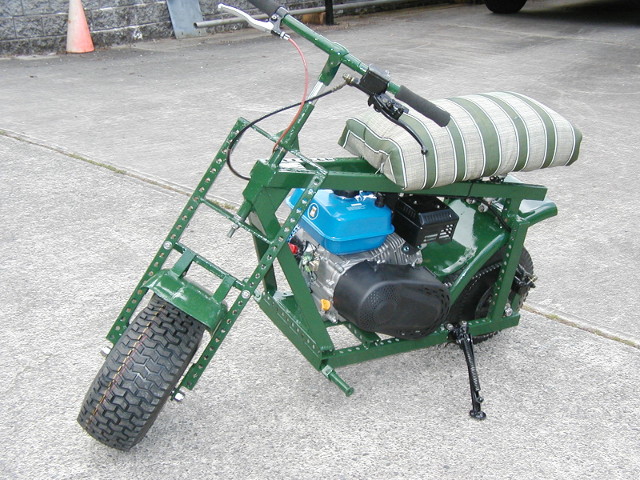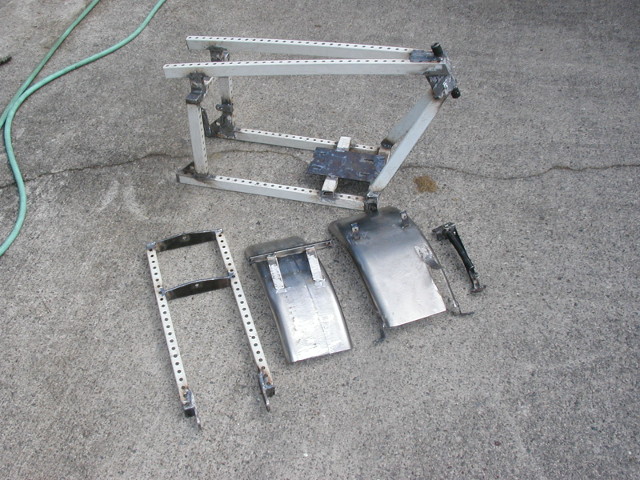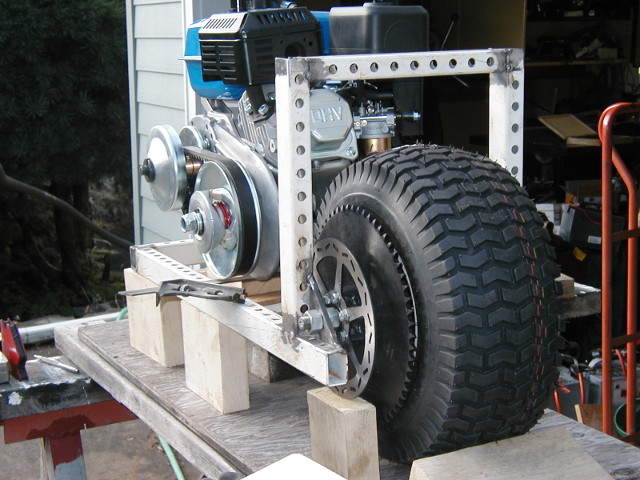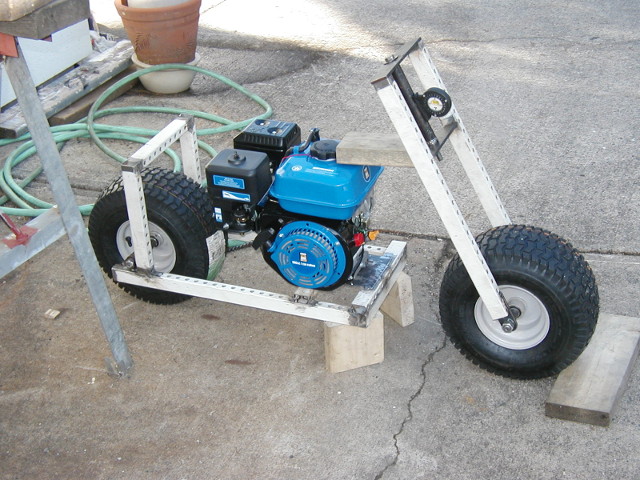
An Off Road Mini-Bike


Description:
This project started out many years ago (like 50 years ago) when I wanted to
build motorized "stuff". One cold November night, not too long ago, I decided
I needed a welding project. Dreams of a mini-bike flashed through my head. As I
now had the tools and skills, I started collecting parts to build up the bike.
This bike was built mostly for slow speed use on decommissioned logging roads.
Top speed is about 30KPH (19MPH). My shop is missing a tubing bender, so I decided
to fab up the frame from various pieces of rectangular tubing. This involves a
little more fitting and welding but allows for a lot of minor adjustments as the
project proceeds. Two key tools I used in building this project are
a wire feed MIG welder and a 14" abrasive chop saw. A couple of items in the steering
and axle assemblies needed the use of a metal lathe for boring and threading.
Plans/Kits:
There are no plans or kits available for this bike. A lot of pieces where cut to fit
so the only plans that exist are ideas in my head as I built up the various
sub assemblies.
Components:
Frame
 The image above shows the various components before final welding or paint.
Most of the steel was sourced through my local recycle yard. I believe the perforated
rectangular tubing was originally commercial store shelving material.
Folding foot pegs were fabricated from some square stock,
1" square tubing, some pipe and a washer. The kickstand was built from
some old channel, a spring from a hide-a-bed sofa, some angle iron and washer from the
junk box. Most of the hardware consists of stainless steel bolts and nylock
nuts from a local marine store.
The image above shows the various components before final welding or paint.
Most of the steel was sourced through my local recycle yard. I believe the perforated
rectangular tubing was originally commercial store shelving material.
Folding foot pegs were fabricated from some square stock,
1" square tubing, some pipe and a washer. The kickstand was built from
some old channel, a spring from a hide-a-bed sofa, some angle iron and washer from the
junk box. Most of the hardware consists of stainless steel bolts and nylock
nuts from a local marine store.
Drive Train
 The picture above shows the mockup of the driveline components while the image below
shows the mockup of the steering geometry.
Wheels, chain, sprockets, fender(s) and the motor were sourced through Princess Auto.
The motor is 196cc and appears to be a clone of a Honda 5HP or so engine. Its a nice unit
that runs great and has a 3/4" drive shaft and low oil cutoff features.
The throttle control is a rear brake lever and cable off an old
mountain bike. I twice ordered a twist grip throttle from China, but after 5 months of
waiting, neither unit arrived. The axles are cut from 5/8" shafting with threads
turned on the lathe. Yes, several chunks of 2x4 and 2x6 where used during the
design process.
The picture above shows the mockup of the driveline components while the image below
shows the mockup of the steering geometry.
Wheels, chain, sprockets, fender(s) and the motor were sourced through Princess Auto.
The motor is 196cc and appears to be a clone of a Honda 5HP or so engine. Its a nice unit
that runs great and has a 3/4" drive shaft and low oil cutoff features.
The throttle control is a rear brake lever and cable off an old
mountain bike. I twice ordered a twist grip throttle from China, but after 5 months of
waiting, neither unit arrived. The axles are cut from 5/8" shafting with threads
turned on the lathe. Yes, several chunks of 2x4 and 2x6 where used during the
design process.

Brakes
The ATV hydraulic brake system was from China via ebay. The caliper, hand lever,
hose and reservoir came as a unit and the 200mm brake disk was from another ebay
supplier. The hydraulic brake is probably overkill, but it works very smoothly and
can easily lock up the rear wheel during "tricks" or panic stops. During normal riding,
the brakes are rarely used as the engine provides significant braking force through
the roughly 18-1 reduction.
Seat
The seat was build up from plywood, some packing foam, parts of an old sofa
cushion and the covering was scavanged from some old lawn furniture. The seat springs
were off an old motorized wheel chair.
Wheels
The wheels were obtained new on sale and I believe they are replacement lawn
tractor front wheels. Originally, the wheels came with 3/4" steel bushings. These
bushings were pressed out and replaced with 5/8" ball bearings. The tires are
a low pressure (15psi) turf pattern. The balloon nature of the tires helps provide
some ride cushion as there is no suspension on the bike. A rear hub assembly had
to be built to support the sprocket and brake disk.
Transmission
The centrifugal
clutch, mounting plate, drive belt and jack shaft came as a unit from an ebay supplier.
The transmission is a Comet TAV2 clone and really makes the bike shine. The clutch
action is very smooth with tons of low end torque and a very smooth transition from
1:3 gearing to 1:1 at high RPMs. The final drive is #41 roller chain to a 60 tooth
sprocket driving the rear wheel.
Steering
The front fork pivot system uses a 1/2" bolt
which rides inside oilite bushings that are press fit in the top and bottom of a
section of bored out pipe. Two thrust bearings were used on the top and bottom
of the steering column to take the vertical loads. The handle bars were salvaged
from an old moutain bike.
Fenders
The fenders were constructed from a single axle steel
trailer fender. The fender was cut to make a front section and a rear section.
The front section was too wide for the forks, and was split lengthwise and rewelded
with an overlap to fit the front forks.

 Back to Lawrence's Home Page
Back to Lawrence's Home Page



 The image above shows the various components before final welding or paint.
Most of the steel was sourced through my local recycle yard. I believe the perforated
rectangular tubing was originally commercial store shelving material.
Folding foot pegs were fabricated from some square stock,
1" square tubing, some pipe and a washer. The kickstand was built from
some old channel, a spring from a hide-a-bed sofa, some angle iron and washer from the
junk box. Most of the hardware consists of stainless steel bolts and nylock
nuts from a local marine store.
The image above shows the various components before final welding or paint.
Most of the steel was sourced through my local recycle yard. I believe the perforated
rectangular tubing was originally commercial store shelving material.
Folding foot pegs were fabricated from some square stock,
1" square tubing, some pipe and a washer. The kickstand was built from
some old channel, a spring from a hide-a-bed sofa, some angle iron and washer from the
junk box. Most of the hardware consists of stainless steel bolts and nylock
nuts from a local marine store.
 The picture above shows the mockup of the driveline components while the image below
shows the mockup of the steering geometry.
Wheels, chain, sprockets, fender(s) and the motor were sourced through Princess Auto.
The motor is 196cc and appears to be a clone of a Honda 5HP or so engine. Its a nice unit
that runs great and has a 3/4" drive shaft and low oil cutoff features.
The throttle control is a rear brake lever and cable off an old
mountain bike. I twice ordered a twist grip throttle from China, but after 5 months of
waiting, neither unit arrived. The axles are cut from 5/8" shafting with threads
turned on the lathe. Yes, several chunks of 2x4 and 2x6 where used during the
design process.
The picture above shows the mockup of the driveline components while the image below
shows the mockup of the steering geometry.
Wheels, chain, sprockets, fender(s) and the motor were sourced through Princess Auto.
The motor is 196cc and appears to be a clone of a Honda 5HP or so engine. Its a nice unit
that runs great and has a 3/4" drive shaft and low oil cutoff features.
The throttle control is a rear brake lever and cable off an old
mountain bike. I twice ordered a twist grip throttle from China, but after 5 months of
waiting, neither unit arrived. The axles are cut from 5/8" shafting with threads
turned on the lathe. Yes, several chunks of 2x4 and 2x6 where used during the
design process.

